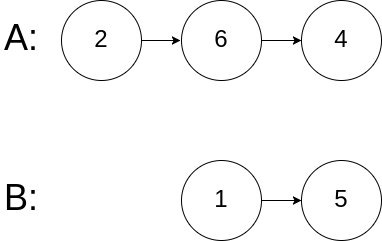
Description
Write a program to find the node at which the intersection of two singly linked lists begins.
For example, the following two linked lists:

begin to intersect at node c1.
Example
Example 1:

1
2
3Input: intersectVal = 8, listA = [4,1,8,4,5], listB = [5,0,1,8,4,5], skipA = 2, skipB = 3
Output: Reference of the node with value = 8
Input Explanation: The intersected node's value is 8 (note that this must not be 0 if the two lists intersect). From the head of A, it reads as [4,1,8,4,5]. From the head of B, it reads as [5,0,1,8,4,5]. There are 2 nodes before the intersected node in A; There are 3 nodes before the intersected node in B.
Example 2:

1
2
3
4
5
6
7
8Input: intersectVal = 2, listA = [0,9,1,2,4], listB = [3,2,4], skipA = 3, skipB = 1
Output: Reference of the node with value = 2
Input Explanation: The intersected node's value is 2 (note that this must not be 0 if the two lists intersect). From the head of A, it reads as [0,9,1,2,4]. From the head of B, it reads as [3,2,4]. There are 3 nodes before the intersected node in A; There are 1 node before the intersected node in B.
```
**Example 3:**

Input: intersectVal = 0, listA = [2,6,4], listB = [1,5], skipA = 3, skipB = 2
Output: null
Input Explanation: From the head of A, it reads as [2,6,4]. From the head of B, it reads as [1,5]. Since the two lists do not intersect, intersectVal must be 0, while skipA and skipB can be arbitrary values.
Explanation: The two lists do not intersect, so return null.1
2
3
4
5
6
7
8
9
10
11
12
13
14
15
16
17
18
19
20
21
22
23
24
25
26
27
28
29
30
31
32
33
34
35
36
37
38
39
40
41
42
43
44
45
46
47
48
49
50
51
52
53
54
55
56
**Notes:**
* If the two linked lists have no intersection at all, return null.
* The linked lists must retain their original structure after the function returns.
* You may assume there are no cycles anywhere in the entire linked structure.
* Your code should preferably run in O(n) time and use only O(1) memory.
## Solution
**Solution 1**
```java
/**
* Definition for singly-linked list.
* public class ListNode {
* int val;
* ListNode next;
* ListNode(int x) {
* val = x;
* next = null;
* }
* }
*/
public class Solution {
// Method 1: calculate length
public ListNode getIntersectionNode(ListNode headA, ListNode headB) {
if (headA == null || headB == null) return null;
int lenA = getLen(headA);
int lenB = getLen(headB);
while(lenA > lenB){
headA = headA.next;
lenA--;
}
while(lenA < lenB){
headB = headB.next;
lenB--;
}
while(headA != headB){
headA = headA.next;
headB = headB.next;
}
return headA;
}
private int getLen(ListNode node){
int res= 0;
while(node != null){
res++;
node = node.next;
}
return res;
}
}
Solution 2
method 2: After the first iteration, the two pointers will be reset to the other list if these two lists have different length. After the longer one reset, the two pointers have the same rest length position to start1
2
3
4
5
6
7
8
9
10
11
12
13
14
15
16
17
18
19
20
21
22
23
24
25/**
* Definition for singly-linked list.
* public class ListNode {
* int val;
* ListNode next;
* ListNode(int x) {
* val = x;
* next = null;
* }
* }
*/
public class Solution {
public ListNode getIntersectionNode(ListNode headA, ListNode headB) {
if (headA == null || headB == null) return null;
ListNode a = headA;
ListNode b = headB;
while(a != b){
a = a == null ? headB : a.next;
b = b == null ? headA : b.next;
}
return a;
}
}